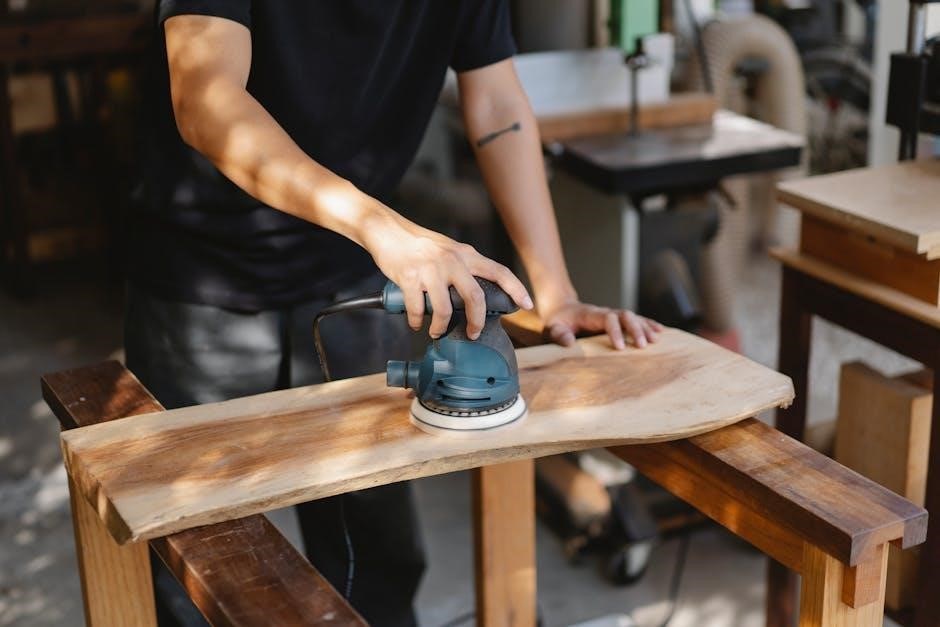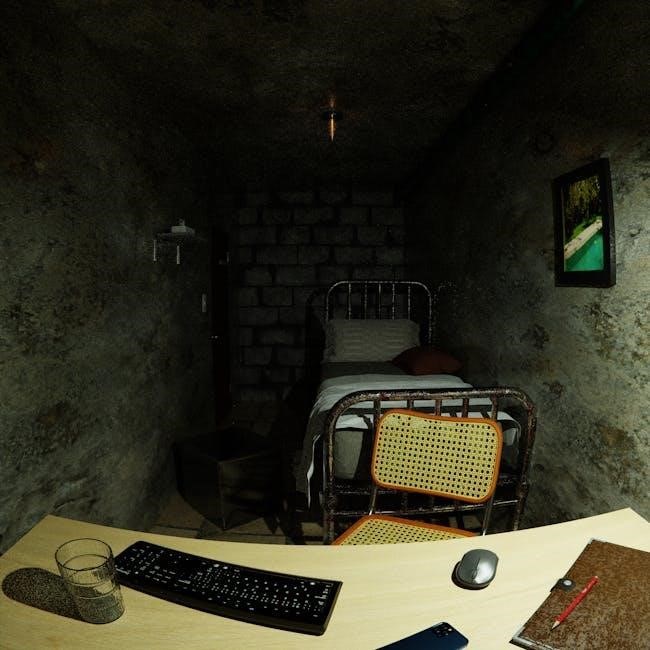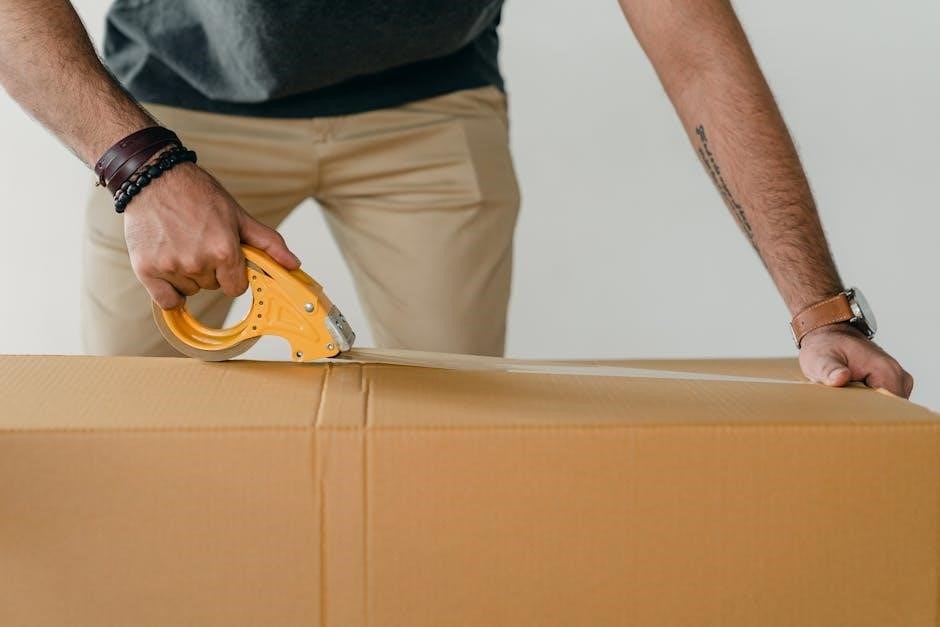Welcome to the Freeflow Spas Manual, your comprehensive guide to understanding and enjoying your affordable, 110v plug-and-play spa․ Designed for energy efficiency and ease of use, Freeflow Spas offer relaxation for every lifestyle․

Key Features of Freeflow Spas
Freeflow Spas offer full foam insulation, rotomolded unibody design, and plug-and-play technology․ They are lightweight, portable, and affordable, with sizes for 2-6 people, perfect for any space or budget․
2․1․ Jets and Massage Systems
Freeflow Spas feature advanced jet and massage systems designed to provide a rejuvenating experience․ With multiple jet configurations, users can enjoy various massage techniques, from gentle relaxation to deep tissue therapy․ The jets are strategically placed to target key muscle groups, ensuring maximum comfort and stress relief․ Additionally, the systems are easy to control, allowing users to adjust intensity and pressure according to their preferences․ The combination of powerful jets and soothing massage options makes Freeflow Spas an excellent choice for those seeking both relaxation and therapeutic benefits․ These systems are also energy-efficient, ensuring that your spa experience remains enjoyable without excessive energy consumption․ Overall, the jets and massage systems in Freeflow Spas are tailored to enhance your wellness routine and provide a luxurious spa experience in the comfort of your own home․
2․2․ Rotomolded Design
Freeflow Spas utilize a cutting-edge rotomolded design, creating a durable and lightweight unibody shell․ This innovative construction method eliminates the need for an internal support frame․ The shell and cabinet are molded as a single piece, ensuring superior structural integrity and longevity․ Rotomolding also allows for unique shapes, such as the popular triangle-shaped spa, perfect for fitting into tight spaces․ This design enhances portability, making it easy to move or relocate the spa as needed․ The seamless construction reduces the risk of leaks and minimizes maintenance․ Additionally, the rotomolded design contributes to energy efficiency by providing excellent insulation․ This combination of durability, versatility, and energy efficiency makes Freeflow Spas an ideal choice for homeowners seeking a low-maintenance, cost-effective hot tub solution․
2․3․ Full Foam Insulation
Freeflow Spas are equipped with full foam insulation, ensuring exceptional energy efficiency and consistent water temperature․ This advanced insulation method involves filling the space between the spa shell and the cabinet with high-density foam, which minimizes heat loss․ As a result, the spa maintains warmth for longer, reducing energy consumption and lowering operating costs․ The foam also acts as a sound dampener, reducing operational noise․ This feature is particularly beneficial in colder climates, as it prevents heat from escaping and keeps the spa warm even in freezing temperatures․ Additionally, full foam insulation protects the spa’s components from moisture and pests, ensuring durability and longevity․ This innovative insulation system makes Freeflow Spas both eco-friendly and cost-effective, providing a relaxing experience while saving energy․
2․4․ Size Options
Freeflow Spas offer a variety of size options to cater to different needs and preferences․ Whether you’re looking for a intimate setting or a spacious experience, there’s a model to suit every lifestyle․ The spas are available in sizes ranging from compact 2-person models to larger 7-person configurations, ensuring there’s a perfect fit for any space or social requirement․ Smaller spas are ideal for personal use or limited areas, while larger models are great for entertaining or family use․ Each size option is designed to provide maximum comfort and relaxation, with strategically placed jets and ergonomic seating․ The diverse size range makes Freeflow Spas adaptable to various outdoor or indoor settings, from cozy balconies to expansive backyards․ This flexibility ensures that users can enjoy a premium spa experience tailored to their unique preferences and surroundings․
2․5․ Plug-and-Play Technology
Freeflow Spas are equipped with advanced plug-and-play technology, designed to simplify installation and operation․ This innovative feature allows users to quickly and effortlessly set up their spa without the need for complex plumbing or electrical work․ The system includes pre-installed components, such as pumps, heaters, and jets, which are ready to function as soon as the spa is connected to a power source․ This technology reduces setup time and effort, making it ideal for homeowners who want a hassle-free experience․ The plug-and-play design also ensures compatibility with standard electrical outlets, eliminating the need for professional installation․ Additionally, it enables easy relocation of the spa, providing flexibility for users who wish to move it to different areas․ This user-friendly feature enhances the overall convenience and accessibility of Freeflow Spas, making them a practical choice for both beginners and experienced spa enthusiasts․
2․6․ Affordability
Freeflow Spas are designed to provide exceptional value without compromising on quality or performance․ Their affordability makes them an accessible option for homeowners seeking a luxury spa experience without the high costs typically associated with traditional hot tubs․ The spas are priced competitively, offering a balance between advanced features and budget-friendly options․ This affordability is achieved through efficient manufacturing processes and the use of durable, cost-effective materials․ The plug-and-play design also reduces installation costs, as no professional setup is required․ Additionally, the energy-efficient technology incorporated into Freeflow Spas helps lower long-term operating expenses․ With a focus on affordability, these spas cater to a wide range of budgets, ensuring that relaxation and wellness are attainable for everyone․ This cost-effectiveness, combined with their durability, makes Freeflow Spas a smart investment for any home․

Design and Construction
Freeflow Spas are crafted with a focus on modern design and durability, ensuring a seamless blend of aesthetics and functionality․ Their user-centric approach prioritizes safety and comfort․
3;1․ Materials Used
Freeflow Spas are constructed using high-quality, durable materials designed to withstand various environmental conditions․ The primary structure is made from heavy-duty, rotomolded plastic, known for its strength and resistance to cracks․ The interior and exterior surfaces are smooth and UV-resistant, ensuring long-lasting performance․ The spa’s frame is reinforced with a sturdy steel structure, providing stability and support․ Insulation is made from thick, high-density foam, which enhances energy efficiency by retaining heat․ Additionally, the pipes and fittings are crafted from durable, chemical-resistant materials to ensure a reliable water circulation system․ The jets are made from high-quality stainless steel, offering superior durability and performance․ All components are carefully selected to ensure safety, longevity, and optimal functionality, making Freeflow Spas a reliable choice for years of enjoyment․
3․2․ Manufacturing Process
The manufacturing process for Freeflow Spas is designed to ensure precision, durability, and quality․ It begins with the creation of the spa shell using a rotomolding process, where polyethylene resin is melted and molded into the desired shape․ The shell is then removed from the mold and allowed to cool before further processing․ Next, the internal components, such as jets, pumps, and plumbing, are carefully assembled and installed․ The spa is then insulated with high-density foam to enhance energy efficiency․ Finally, the unit undergoes rigorous testing to ensure all systems function properly․ Quality control checks are performed at every stage to meet safety and performance standards․ This meticulous process ensures that every Freeflow Spa is built to last, providing years of reliable service and enjoyment․

Installation and Setup Guide
Proper installation ensures safe and optimal performance․ Begin with site preparation, ensuring a level, sturdy surface․ Position the spa, connect electrical and plumbing systems, and fill with water․ Follow guidelines carefully․
4․1․ Site Preparation

Proper site preparation is essential for safe and efficient installation․ Choose a flat, stable surface, such as concrete or reinforced decking, to support the spa’s weight․ Ensure the area is level to prevent uneven settling․ If placing on grass, install a sturdy base to avoid sinking․ Check for proper drainage to prevent water accumulation․ Position the spa near a power source and water supply for convenience․ Ensure accessibility for maintenance and future servicing․ Avoid shaded areas to reduce leaf debris accumulation․ Finally, inspect the site for any obstructions or hazards․ A well-prepared site ensures a smooth installation process and optimal performance of your Freeflow Spa․
4․2․ Electrical Requirements
Ensure your Freeflow Spa is installed by a licensed electrician to meet local electrical codes․ The spa requires a dedicated 220V, 40-50 amp electrical circuit, depending on the model․ Use a Ground Fault Circuit Interrupter (GFCI)-protected circuit to ensure safety․ The circuit breaker should be rated appropriately for the spa’s power consumption․ Avoid sharing the circuit with other appliances to prevent electrical overload․ Use 6 AWG copper wiring for the connection to ensure reliable power delivery․ Always follow the manufacturer’s wiring diagram provided in the manual․ Local electrical regulations must be adhered to, and inspections may be required․ Proper electrical installation is crucial for safe and efficient spa operation․ Consult the manual for specific electrical requirements for your Freeflow Spa model․
4․3․ Filling with Water
Filling your Freeflow Spa with water is a straightforward process that requires attention to detail to ensure optimal performance․ Begin by locating a clean, accessible water source, such as a garden hose with a filter attachment to prevent debris from entering the spa․ Open the drain valve located at the bottom of the spa to access the water inlet․ Slowly fill the spa to the recommended water level, which is typically just above the jets․ Avoid overfilling, as this can lead to water displacement when users enter the spa․ Once filled, close the drain valve and inspect the connections for leaks․ Use a test strip to check the water’s pH and alkalinity levels before use․ Always refer to your Freeflow Spas manual for specific filling instructions tailored to your model․ Proper water levels ensure efficient operation and longevity of the spa system․

Operating Instructions
Operate your Freeflow Spa by following the control panel instructions․ Ensure the area is clear, maintain proper water levels, and follow all safety guidelines for a relaxing experience․
5․1․ Starting the Spa
To start your Freeflow Spa, begin by ensuring the water level is at the recommended height, as indicated by the markings on the spa’s side․ Next, verify that the spa is properly plugged into a suitable electrical outlet that meets the required voltage specifications․ Once these steps are completed, locate the power button or switch on the control panel and press it to turn on the spa․ Allow the system to initialize, which may include a brief period for the pumps and heating elements to activate․ After the spa is on, you can adjust the temperature settings using the control panel․ It’s important to review the safety precautions in the manual to ensure a safe and enjoyable experience․ Regularly check the water level and electrical connections to maintain optimal performance․
5․2․ Adjusting Temperature
To adjust the temperature on your Freeflow Spa, locate the digital control panel typically situated on the top or side of the spa․ Ensure the spa is powered on by pressing the power button, which will illuminate the display․ Use the up and down arrows or a dial to increase or decrease the temperature․ Many models allow setting a specific temperature for consistent warmth․ Check if the display is in Celsius or Fahrenheit and adjust as needed․ Heating times vary, but the manual provides guidelines․ For safety, avoid exceeding the maximum recommended temperature to prevent burns․ Consider energy-saving features like eco-mode to reduce energy consumption when the spa is not in use․ Always refer to the manual for precise instructions to ensure safe and efficient temperature adjustments․
5․3․ Regular Use Guidelines

For optimal enjoyment and longevity of your Freeflow Spa, follow these regular use guidelines․ Always ensure the water temperature is set between 98°F and 104°F for safe soaking․ Before each use, inspect the spa cover for proper fit and remove it carefully to avoid damage․ Maintain proper water chemistry by testing and adjusting pH and sanitizer levels regularly․ Avoid using the spa if you have open wounds or certain medical conditions without consulting a healthcare professional․ Limit soaking sessions to 15–20 minutes to prevent overheating․ Keep the spa area clean and clear of debris to ensure safety․ Supervise children and pets when the spa is in use․ Regularly clean the filters and check for wear and tear․ By adhering to these guidelines, you can enjoy a safe and relaxing experience while preserving the performance of your Freeflow Spa․

Maintenance and Upkeep
Regular maintenance is essential to ensure your Freeflow Spa operates efficiently and remains in excellent condition․ Clean filters, inspect equipment, and maintain proper chemical balance to preserve performance and longevity․
6․1․ Cleaning the Spa
Cleaning your Freeflow Spa regularly is crucial for maintaining hygiene and performance․ Start by turning off the power and draining the water․ Use a soft brush or sponge to wipe down the interior surfaces, paying attention to areas around jets and seats where dirt accumulates․ For tougher stains, apply a mild cleaner specifically designed for spas․ Avoid harsh chemicals that might damage the materials․ Clean or replace the filters every 1-2 weeks, depending on usage, to ensure proper water circulation․ For the exterior, use a gentle, non-abrasive cleaner to maintain the finish․ Regularly test and balance the water chemistry to prevent algae growth and bacterial buildup․ Finally, drain and refill the spa every 3-4 months or as needed to keep the water fresh and clean․ Consistent cleaning habits will extend the life of your spa and ensure a relaxing experience․
6․2․ Chemical Maintenance
Proper chemical maintenance is essential for keeping your Freeflow Spa safe, clean, and enjoyable․ Start by testing the water regularly for pH, alkalinity, and calcium hardness levels․ Adjust these levels as needed to maintain a pH range of 7․2–7․8 and alkalinity of 80–120 ppm to prevent corrosion and eye irritation․ Use a sanitizer, such as chlorine or bromine, to maintain a level of 1–3 ppm to kill bacteria and contaminants․ Shock the spa weekly to eliminate organic compounds that cloud the water or cause odors․ Always follow the manufacturer’s instructions for chemical dosages to avoid over-chlorination, which can damage equipment or irritate skin․ Regularly monitor and adjust chemical levels, especially after heavy use or extreme temperature changes․ Proper chemical balance ensures a safe, hygienic, and enjoyable spa experience while protecting the system from damage․
6․3․ Winterizing the Spa
Winterizing your Freeflow Spa is crucial to protect it from freezing temperatures and potential damage․ Start by draining the spa completely using the built-in drainage system or a submersible pump․ Clean the spa shell, seats, and surfaces thoroughly to remove dirt and bacteria․ Inspect and clean the filter cartridges, and apply a filter cleaner for optimal performance․ Use a spa-specific antifreeze solution to protect the plumbing and pipes from freezing․ Disconnect and drain all external equipment, such as hoses and jets, to ensure no water remains․ Cover the spa with a high-quality cover to prevent debris and moisture from entering․ Finally, unplug the spa and store any accessories in a dry place․ Regular winter checks can help maintain your spa’s condition and ensure it’s ready for use when warmer weather returns․ Proper winterization extends the lifespan of your Freeflow Spa and prevents costly repairs․

Safety Precautions
Always supervise children and ensure they understand spa safety․ Avoid alcohol and drugs while using the spa․ Consult a doctor before use if you have health conditions․ Keep the area around the spa clear of obstacles and ensure proper ventilation․ Never touch electrical components with wet hands․ Follow all warning labels and instructions provided in the manual․ Regularly inspect the spa and its components for damage․ Ensure the spa cover is securely in place when not in use to prevent accidents․ Follow all local safety regulations and guidelines for spa operation․ Proper safety practices will ensure a safe and enjoyable experience for everyone using the Freeflow Spa․
7․1․ General Safety Tips
Always ensure the spa area is clear of obstacles to prevent tripping․ Supervise children and pets when they are near the spa․ Avoid using the spa if you have open wounds or skin infections․ Never use electrical appliances near the spa while it is in operation․ Keep the spa cover securely closed when not in use to prevent accidental drowning․ Avoid overheating the spa, as excessive heat can cause dizziness or fainting․ Do not use the spa if you have a fever or are experiencing high blood pressure․ Ensure all users shower before entering the spa to maintain cleanliness․ Keep a first aid kit nearby and ensure someone knows how to administer basic first aid․ Avoid using the spa during thunderstorms or extreme weather conditions․ Follow all safety guidelines provided in the manual to ensure a safe and enjoyable experience․
7․2․ Emergency Procedures
In case of an emergency, remain calm and act quickly․ If someone experiences dizziness, nausea, or fainting while in the spa, immediately assist them out and provide fresh air․ For electrical issues, turn off the power at the circuit breaker and do not attempt to touch the spa until it is safe․ If a chemical spill occurs, neutralize the area with water and ventilate thoroughly․ In case of a medical emergency, such as a heart attack or seizure, call emergency services immediately and provide first aid if trained․ For burns from hot surfaces or water, run cool tap water over the affected area and seek medical attention․ During thunderstorms, evacuate the spa area and avoid returning until the weather clears․ Keep emergency contact numbers nearby, such as your local emergency service and poison control․ Always have a first aid kit accessible․ Regularly review these procedures to ensure preparedness․

Troubleshooting Common Issues
Identify and address issues promptly to ensure optimal performance․ Common problems include malfunctioning jets, temperature fluctuations, or power supply disruptions․ Always refer to the manual for specific solutions or contact Freeflow Spas support for assistance․
8․1․ Common Problems
Freeflow Spas are durable, but occasional issues may arise․ Common problems include jets not functioning, uneven water temperature, or the spa failing to power on․ These issues often stem from clogged jets, faulty heaters, or electrical connectivity problems․ Users may also experience water leakage or excessive noise during operation, which could indicate worn seals or malfunctioning pumps․ Additionally, improper chemical balance or insufficient water levels might cause system errors․ Regular maintenance can prevent many of these issues, but when they occur, troubleshooting steps such as checking power supply, cleaning filters, or restarting the system often resolve the problem․ If issues persist, consulting the manual or contacting Freeflow Spas support is recommended for professional assistance․
8․2․ Advanced Troubleshooting
For persistent or complex issues with your Freeflow Spa, advanced troubleshooting techniques may be necessary․ Start by checking the control panel for error codes, which can provide specific insights into the problem․ Resetting the system or performing a factory reset may resolve software-related glitches․ Inspect the electrical connections and ensure they are secure, as loose wires can disrupt functionality․ If water circulation is uneven, check the pump and valves for blockages or damage․ For heating issues, verify the heater element and thermostat are functioning correctly․ Advanced users can also test sensors and components using multimeters or specialized tools․ If problems persist, consult the manual for diagnostic charts or contact a certified technician for professional assistance․ Always prioritize safety when handling electrical or mechanical components․
